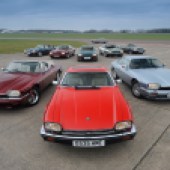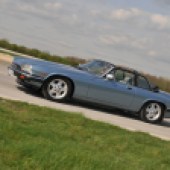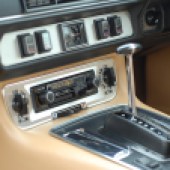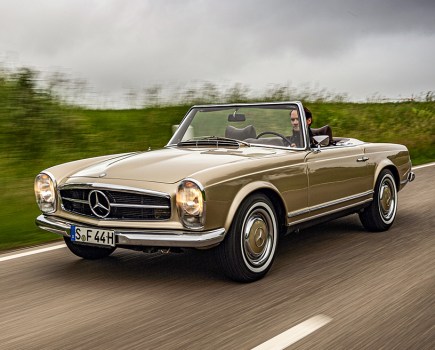Now finally receiving the respect it arguably always deserved, the Jaguar XJS is a fantastic grand tourer. Here’s how to buy a good one
The Jaguar XJ-S, commonly known by its later hyphen-less XJS name, was a controversial offering when new – but like so many flops of the period, it has since matured into a highly desirable classic. Various well-judged updates occurred over the car’s considerable 21-year lifespan; a production period that helped it beat the E-type’s sales record by attracting more than 115,000 customers worldwide.
At the time of its launch, not everyone appreciated the XJS’s styling (particularly its trailing rear buttresses), nor the fact that the only power option was Jaguar’s less-than-frugal 5.3-litre V12, offered at a time when the most recent energy crisis was still fresh in everyone’s mind. But despite a slow start, Jaguar didn’t give up on the XJS, and through a long-term process of updates the company’s sportiest model began to prosper.
Given the longevity of the XJS, many forget that it was in danger of being dropped from the Jaguar lineup as early as the start of the 80s, with just 1,057 cars sold worldwide in 1980 compared with 3,890 three years earlier. Instead, Jaguar focused on improving both the car’s design and its overall quality and reliability, as well as expanding the range to appeal to a broader spread of customers.
The summer of 1981 (three years before Jaguar was separated from BL and became an independent company once again) saw the launch of an updated version of the V12 engine, featuring a Michael May-designed split-level combustion chamber for greater efficiency. The effect was dramatic, with an increase in power being a welcome bonus, alongside an all-important improvement in fuel economy; the XJS HE (for ‘High Efficiency’) was suddenly capable of up to 20mpg on a run.

Buyers who craved an open-top version of the Jaguar XJS had to wait a further two years for the launch of the XJ-SC, a model that featured targa-style removable hardtop panels and a fold-down rear window; it was the closest that Jaguar had come to creating a ragtop version of its sporting coupe, but many enthusiasts still craved a full convertible.
Their prayers were eventually answered in 1988, when the logically-named XJS Convertible arrived to replace the XJ-SC, bringing with it a newly strengthened bodyshell to ensure extra rigidity. And what an impressive looking vehicle this was, finally providing XJS fans with one of the most elegant soft-top experiences of the time. At long last, what many had perceived to be an ugly duckling thirteen years earlier had matured into the proverbial handsome swan.
One of the most important developments in the history of the XJS, however, occurred at the same time as the XJ-SC’s debut in 1983, with the announcement of a new six-cylinder engine. No longer was the classic 5.3-litre V12 the only power option, with the all-new 3.6-litre 24-valve AJ6 straight-six unit helping to significantly boost sales. Although the V12’s power output of 291bhp (for the 1983-on HE model) was always the ultimate, the AJ6’s initial 221bhp was powerful enough for most buyers’ needs.
The arrival of a six-cylinder XJS did wonders for sales, helping it to remain competitive and popular well into the Nineties. Updates continued during that decade, with 1991 bringing a subtle restyle for the coupe, which now featured larger-looking glass areas and a modified rear end for a touch of extra elegance.
The six-cylinder engine was upgraded to 4.0-litre capacity that same year, while May 1992 saw the legendary V12 powerplant become a 6.0-litre unit – with power increased to 313bhp as a result. But with the new XK8 waiting in the wings, the final XJS rolled off the line in 1996, bringing to an end one of Jaguar’s most successful sporting sagas.
Bodywork
One of the XJS’s biggest enemies nowadays is rust, making it essential that you carry out thorough checks before purchase. Underneath the car, start your inspection with the jacking points, as rot here can result in holes and general weakening of the area; push firmly around the jacking points for signs of weakness, and be suspicious of any uneven surfaces or fresh underseal.
The XJS’s floorpans are also prone to rot, particularly around the coupe model’s seatbelt mounting reinforcement, where a strengthening plate on the outside allows water to get trapped; this then rots the floor, creating major problems.
When it comes to outer panels, the bottom of each front wing (where it meets the sill) is particularly vulnerable to corrosion. Check that the bottom of the wing is flush with the sill; if it isn’t, then assume that a less-than-perfect repair has been carried out. The wings also need checking around their headlights and wheelarches, as well as along their top edges; new wings are available (at around £485 per side) but it’s worth considering if you want to take on a project car.
Rust around the rear wheelarches is common, plus the front lower edge of each rear wing (where it joins the sill); if there isn’t an obvious seam here, then the area has been poorly repaired and filled over. Check each sill, as these can rust through; examine the sill closing plates from under the wheelarches, and look for any signs that cover sills are hiding rusty originals. You should also check each door for signs of rust or repairs, as corrosion to both skin and frame isn’t unusual; a new door skin will cost you around £180.
Even the galvanized post-facelift (1991-on) XJS isn’t immune to rust; one of the most common areas is around the windscreen scuttle, which is tricky and expensive to repair properly.
On post-1993 cars in particular, rust is often an issue forward edge of the roof, where it meets the stainless steel fastener.

Engine and transmission
Many buyers might baulk at the thought of running (and maintaining) a V12, Jaguar’s classic powerplant is an inherently reliable unit – as long as its owner is fastidious when it comes to maintenance. Its coolant must be replaced every two years (using good quality antifreeze), for example, as the radiator tends to silt up quickly. If the coolant in the XJS you’re thinking of buying looks brown rather than clean and green, then find another car.
The V12 is famously smooth, with only the rattle of a loose timing chain (a common feature on higher-mileage cars in particular) to spoil the serenity. When buying any XJS, the lack of a service history or proof of maintenance should set alarm bells ringing. Similarly, if the engine you’re listening seems noisy, walk away.
The straight-six AJ6 engine is a reliable unit, with marque specialist KWE Cars reckoning on mileages of up to 150,000 before things start to get expensive – although this will depend on good maintenance.
Head gaskets can fail after just 50,000 miles or so, so make sure you carry out all the usual checks for coolant in the engine oil and vice-versa.
Check that the oil pressure is around 40–50psi once the engine is at normal operating temperature; and listen out for timing chain rattles, as the AJ6 (and 4.0-litre AJ16) unit is prone to this on higher-mileage cars, which might involve replacing both the timing chain and tensioner.
Most XJS V12s come with the smooth GM400 three-speed auto unit from the late 70s onwards. This was replaced by a four-speed version of the same box in 1993. However, the AJ6-engined models started off with a Getrag 265 five-speed manual transmission, joined in 1987 by an optional ZF 4HP22 four-speed automatic.
Whichever automatic gearbox is fitted, check for smooth, quick changes up and down the gears and non-hesitant ‘kickdown’. If there’s any knocking from underneath this is usually a problem with gearbox mounts, allowing the ‘box itself to move. On manual cars, check for any crunching of the gears (particularly on first and second) and make sure there’s no clutch slip.

Suspension, steering and brakes
Look for steering leaks and listen for any untoward noises when turning from lock to lock. On the braking front, the all-disc standard set-up is relatively uncomplicated and has no inherent faults; check, however, that the discs and pads aren’t at the end of their life, and ask when the brake fluid was last changed.
The XJS’s twin-wishbone front suspension has top inner bushes that tend to wear out every 50,000 miles or so, allowing the wishbones to move around, which affects the tracking and causes uneven tyre wear.
The rear suspension is contained in a subframe that also holds the differential; if possible, try levering down on the subframe mounts (with the body supported) to check for perishing, while rocking each wheel side-to-side to check the health of the hub bearings.

Interior, trim and electrics
Any XJS was a well-equipped car for its time, which means plenty of potential for things going wrong. The electrics can be troublesome, so make sure everything is working as it should – including the electric windows, aerial and so on, whilst keeping an eye on any warning light glitches. Make sure the gauges are all functioning, and on convertible cars check that the hood mechanism is working correctly.
The well-trimmed interior tends to last well, but you should still check the leather upholstery for signs of wear and damage – particularly the side bolsters of the front seats. Also inspect the carpets for signs of dampness, which might be caused by a leaking screen or rot around the scuttle.
The wood-veneer used on the dashboard, centre console and door cappings can suffer from cracked or even flaking lacquer on neglected cars, so check this carefully as a professional repair will be pricy. If you’re buying a convertible (or the rarer XJ-SC), check the condition of the hood itself, looking for any wear and splits in the fabric.
Jaguar XJS: our verdict
For a car that started out in life as a disappointment to many, the XJS went on to achieve the almost impossible. Here was a car that frustrated those who were looking for a ‘new E-type’ upon its launch in 1975, thanks to its hardtop-only spec and controversial styling; but by the early 80s, the XJS finally began to fulfil its potential via roofless options and an extra engine choice, opening up a whole new audience as a result. The fact that the final XJS was produced 21 years after the original was in itself a major feat.
The XJS is now a highly respected grand-touring classic, with the best examples seeing an upsurge in values over the last few years thanks to increased demand. In both six-cylinder and V12 guises, it offers effortless performance, impressive refinement and a great all-round driving experience.
We wouldn’t necessarily recommend a project car unless without serious funds in reserive, but for anyone with the budget for a well-preserved survivor, an XJS should prove to be a rewarding choice.
Jaguar XJ-S timeline
1967
Works begins on Jaguar E-type replacement known internally as XJ21
1968
Jaguar now under British Leyland; XJ21 project is cancelled
Jaguar XJ27 project begins as an XJ-based 2+2 sports car, taking inspiration from the Bertone Pirana concept first shown at the 1967 Earls Court Motor Show
1970
Original XJ27 designer Malcolm Sayer dies; final details left to design team under William Lyons
1972
First running XJ27 prototypes completed
1975
Jaguar XJ-S launched at the Frankfurt Motor Show in September with 4.3-litre V12 power
1977
BorgWarner Model 12 automatic transmission replaced with GM Turbo-Hydramatic 400
1981
Jaguar XJ-S HE arrives with high-efficiency V12 engine producing 295hp. Subtle styling and trim changes also introduced
1983
AJ6 straight-six arrives, initially only available in the XJ-SC
1987
Sportspack offered as an option with stiffer springs, uprated dampers, larger front anti-roll bar, and more
1988
Sportspack specification now standard
XJR-S model arrives

Jaguar XJR-S
1989
AJ6 engine enlarged to 4.0 litres with power upped to 223bhp
1991
Facelift introduced, with 4.0-litre AJ6 engine, outboard brakes and other detail changes, including hyphenless rebrand to XJS
1992
6.0-litre V12 engine introduced
1994
AJ6 engine upgraded to AJ16 specification
Production of closely related Aston Martin DB7 begins
1995
XJS Celebration run-out model arrives celebrating Jaguar’s 60th anniversary
1996
Jaguar XJS discontinued
1997
Jaguar XK8 arrives as XJS replacement










































